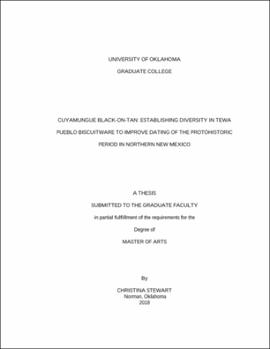| dc.description.abstract | Researchers know that during the Late Classic period (A.D. 1500-1598) Tewa Pueblo people living in the Lower Chama watershed started moving southeast towards the Rio Grande, a process that eventually lead to the depopulation of the valley. However, archaeologists are still unsure of why and when Tewa people started to depopulate the Chama. There are several explanations researchers use to explain why Tewa people started leaving the area that date to a specific time of Tewa history between the Late Classic period and Historic period (1598-1760). The explanations range from environmental instability in the Late Classic period (Towner and Salzer 2013), the spread of European diseases (Ramenofsky 1988), or the increased demands of Athapaskan raiding (Hammond and Rey 1953:1059) and Spanish colonial policies of population concentration (Wozniak 1992) during the Historic period. One way to address this challenge of understanding why Tewa people started moving south is to better date the later occupation of sites in the region. In this thesis I argue that a way to improve the dating Late Classic period sites in the Lower Chama watershed is to analyze the abundant and locally-produced biscuitware ceramics to better resolve the Tewa ceramic typology.
There are two accepted biscuitware types, Abiquiu Black-on-gray (Biscuit A) and Bandelier Black-on-gray (Biscuit B), with wide chronological dates. In this study I evaluated Harlow’s (1973) observations to investigate if there is an identifiable third and later type, Cuyamungue Black-on-tan (Biscuit C), that would allow researchers better address these chronological issues in the region. Harlow (1973) argued Late Classic period (A.D. 1500-1598) biscuitwares have taller rims, a tanner slip, and thinner
walls than the preceding Abiquiu Black-on-gray and Bandelier Black-on-gray. In this study, I evaluated Harlow’s (1973) observations about changing biscuitware forms during the Classic period at the site of Sapa’owingeh (LA 306), by analyzing 2,519 sherds from across the village. Based on this analysis there were statistically significant differences in the rim height, slip color, and wall thickness that support Harlow’s Cuyamungue Black-on-tan type. Additionally, I found statistically significant differences between types in the presence of firing cores, the shapes of rims, the correlation of banding lines to rim height, and the presence of mica in the slips of biscuitwares. Therefore, Cuyamungue Black-on-tan is a type that researchers can use to refine dating of Late Classic period sites in the Northern Rio Grande, which will help archaeologists to improve our understanding of why Tewa people started leaving the region during the Late Classic period. Understanding when and why Tewa people left the Chama has implications for the way that researchers understand Tewa connections to the Lower Chama watershed, and dealt with the many pressures of Spanish contact and colonization. | en_US |
